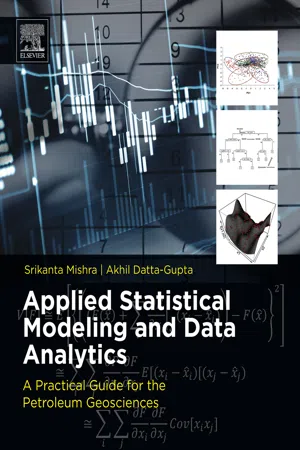
Applied Statistical Modeling and Data Analytics
A Practical Guide for the Petroleum Geosciences
- 250 pages
- English
- ePUB (mobile friendly)
- Available on iOS & Android
Applied Statistical Modeling and Data Analytics
A Practical Guide for the Petroleum Geosciences
About This Book
Applied Statistical Modeling and Data Analytics: A Practical Guide for the Petroleum Geosciences provides a practical guide to many of the classical and modern statistical techniques that have become established for oil and gas professionals in recent years. It serves as a "how to" reference volume for the practicing petroleum engineer or geoscientist interested in applying statistical methods in formation evaluation, reservoir characterization, reservoir modeling and management, and uncertainty quantification.
Beginning with a foundational discussion of exploratory data analysis, probability distributions and linear regression modeling, the book focuses on fundamentals and practical examples of such key topics as multivariate analysis, uncertainty quantification, data-driven modeling, and experimental design and response surface analysis. Data sets from the petroleum geosciences are extensively used to demonstrate the applicability of these techniques. The book will also be useful for professionals dealing with subsurface flow problems in hydrogeology, geologic carbon sequestration, and nuclear waste disposal.
- Authored by internationally renowned experts in developing and applying statistical methods for oil & gas and other subsurface problem domains
- Written by practitioners for practitioners
- Presents an easy to follow narrative which progresses from simple concepts to more challenging ones
- Includes online resources with software applications and practical examples for the most relevant and popular statistical methods, using data sets from the petroleum geosciences
- Addresses the theory and practice of statistical modeling and data analytics from the perspective of petroleum geoscience applications
Frequently asked questions
Information
Basic Concepts
Abstract
Keywords
1.1 Background and Scope
1.1.1 What Is Statistics?

Table of contents
- Cover image
- Title page
- Table of Contents
- Copyright
- Dedication
- Preface
- Acknowledgments
- Chapter 1: Basic Concepts
- Chapter 2: Exploratory Data Analysis
- Chapter 3: Distributions and Models Thereof
- Chapter 4: Regression Modeling and Analysis
- Chapter 5: Multivariate Data Analysis
- Chapter 6: Uncertainty Quantification
- Chapter 7: Experimental Design and Response Surface Analysis
- Chapter 8: Data-Driven Modeling
- Chapter 9: Concluding Remarks
- Index